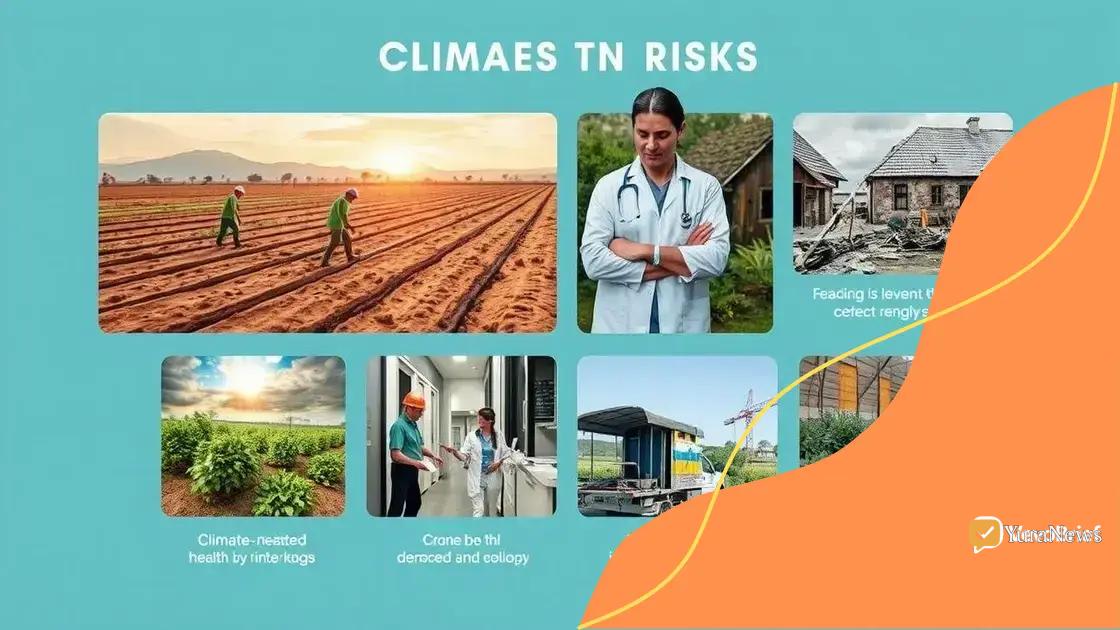Federal report: rising climate risks demand urgent action

Anúncios
The federal report on rising climate risks highlights urgent issues affecting sectors like agriculture and health, emphasizing the need for immediate mitigation strategies and effective policy recommendations to build a sustainable future.
Federal report: rising climate risks is shedding light on pressing issues that could affect our lives and environment. How can we adapt to these changes and ensure a sustainable future? Let’s delve deeper into what this report reveals.
Anúncios
Understanding the federal report on climate risks
The federal report on climate risks provides important insights into how climate change is impacting our world. Understanding these findings helps us to grasp the seriousness of climate-related issues. This report is a vital tool for policymakers and citizens alike.
Key Components of the Report
In the report, various key components are discussed, each highlighting different aspects of climate risks. From rising sea levels to increased weather variability, the findings are alarming yet informative.
- Rising sea levels: Coastal regions are particularly vulnerable. The report indicates a significant increase in sea levels over the past decades.
- Extreme weather events: Hurricanes, droughts, and floods are becoming more common and severe, directly affecting our communities.
- Impact on biodiversity: Changing climates threaten numerous species, which can disrupt entire ecosystems.
Alongside these findings, it’s crucial to consider how the report recommends addressing these risks. Awareness is the first step towards action.
Anúncios
Recommendations for Action
The federal report also includes recommendations aimed at mitigating the impacts of climate risks. Strategies include enhancing resilience in communities and investing in sustainable technologies.
Furthermore, collaboration among government entities, businesses, and citizens is essential. By working together, we can tackle these challenges head-on. Adaptation and preparedness programs can make a difference in how we respond to climate change.
Ultimately, understanding the federal report on climate risks equips us with the knowledge needed to advocate for the changes necessary to protect our planet. As individuals, we can do our part by staying informed and supporting policies that address these urgent challenges.
Key findings related to rising climate challenges
The key findings related to rising climate challenges in the federal report reveal alarming trends that affect both our environment and society. Each finding underscores the urgency of addressing these issues.
Understanding Climate Trends
One striking finding is the evident increase in global temperatures. Over the past century, temperatures have risen significantly, causing changes in weather patterns and leading to unpredictable climates.
- Increased heatwaves: Many regions have noted more frequent and intense heatwaves, which can have severe health impacts.
- Shifts in precipitation: Some areas face increased rainfall, while others experience prolonged droughts, challenging water resources.
- Declining snowpack: Snow levels in mountainous regions are decreasing, affecting water supply and ecosystems.
These findings highlight the interconnectedness of climate systems and the imperative for effective response strategies.
Impact on Ecosystems
Another critical aspect of the report discusses the impact of climate change on ecosystems. Species are struggling to adapt, leading to shifts in biodiversity. Endangered species are at greater risk as their habitats change or disappear altogether.
Furthermore, the rise in temperatures affects migration patterns and breeding seasons of wildlife, creating imbalances in nature. As these ecosystems falter, the services they provide, such as pollination and clean water, are also jeopardized. This situation signals to us that our actions must reflect the urgency of these findings.
With these key findings related to rising climate challenges in mind, it’s clear that understanding these patterns is vital for informed decision-making. Moving towards sustainable practices can diminish these impacts and foster resilience.
Impacts of climate risks on various sectors

The impacts of climate risks are extensive, affecting multiple sectors of society and the economy. Each sector faces unique challenges that demand urgent attention and action.
Agriculture
In agriculture, changing weather patterns lead to decreased yields. Farmers are experiencing more frequent droughts and unpredictable rainfall, which hinders planting and harvesting.
- Crop failure: Extreme weather can destroy crops, leading to food shortages.
- Pest outbreaks: Warmer temperatures can increase pest populations, further threatening crops.
- Increased operational costs: Farmers must spend more on irrigation and pest control.
These factors contribute to food insecurity, making it a priority for communities to find sustainable solutions.
Health Sector
The health sector also suffers from climate risks, as rising temperatures can lead to health problems. Heat-related illnesses and respiratory issues are becoming more common.
Moreover, vulnerable populations, such as the elderly, are at greater risk during heatwaves. Vector-borne diseases like malaria and dengue can spread to new regions, putting more people at risk.
Addressing these health impacts requires a comprehensive public health response.
Infrastructure
Infrastructure is not spared either. Rising sea levels and extreme weather events damage roads, bridges, and buildings. The costs of repairing and adapting infrastructure can be overwhelming.
- Increased maintenance costs: Cities need to invest more in resilient infrastructure.
- Service disruption: Extreme weather can lead to outages in essential services like water and electricity.
- Urban planning challenges: Planners must consider future climate risks in their designs.
By recognizing the impacts of climate risks on various sectors, we can work towards integrated solutions that address these challenges effectively.
Strategies for mitigating climate-related issues
Implementing strategies for mitigating climate-related issues is essential for reducing the impacts of climate change. These strategies can help communities adapt while also taking steps to minimize future risks.
Sustainable Practices in Agriculture
One effective strategy involves adopting sustainable agricultural practices. This can include techniques such as crop rotation and organic farming.
- Soil health improvement: Healthy soil retains water better and supports plant growth.
- Diverse crops: Growing a variety of crops can reduce pest problems and enhance resilience.
- Water management: Efficient irrigation techniques save water and improve yields.
By implementing these practices, farmers can better prepare for changing weather conditions and ensure food security.
Investment in Renewable Energy
Another crucial strategy is investing in renewable energy sources, such as solar and wind power. Transitioning from fossil fuels to cleaner energy reduces greenhouse gas emissions.
Governments and companies can also incentivize the use of energy-efficient technologies. This includes promoting electric vehicles and retrofitting buildings for better energy efficiency.
Enhancing Urban Resilience
Improving urban infrastructure is vital for coping with climate impacts. Cities should focus on making buildings and transportation systems more resilient to extreme weather events.
- Green spaces: Planting trees and creating parks can improve air quality and reduce heat.
- Flood management: Designing systems that can effectively manage stormwater reduces flood risk.
- Community engagement: Involving residents in planning can lead to more effective climate solutions.
By focusing on these strategies for mitigating climate-related issues, communities can foster a sustainable future and reduce vulnerability to climate risks.
Future outlook and policy recommendations
The future outlook and policy recommendations are essential for addressing the challenges posed by climate change. As we anticipate ongoing climate risks, developing effective policies will play a crucial role in guiding our response.
Anticipated Climate Trends
Experts predict that climate change will intensify in the coming years. Global temperatures are expected to rise further, leading to more frequent and severe weather events.
- Increased heat: Heatwaves may become more common, impacting health and agriculture.
- More storms: Coastal areas could face stronger hurricanes and flooding.
- Changing ecosystems: Altered habitats will affect wildlife and plant species.
These anticipated changes emphasize the importance of proactive measures.
Policy Recommendations
To effectively address these challenges, a comprehensive approach to policymaking is necessary. Implementing policies that promote sustainability and resilience is vital.
Governments should focus on:
- Investing in clean energy: Supporting renewable energy projects can reduce reliance on fossil fuels.
- Strengthening infrastructure: Enhancing the resilience of existing structures ensures they can withstand climate impacts.
- Implementing conservation strategies: Preserving natural habitats and biodiversity helps maintain ecosystem balance.
Moreover, engaging communities in decision-making fosters support for climate initiatives. Public awareness campaigns can educate citizens about the importance of participating in climate action.
By focusing on these future outlook and policy recommendations, stakeholders can create a sustainable framework for combating climate change. Together, we can build a resilient future for generations to come.
In conclusion, addressing climate change is critical for the future of our planet. We must recognize the impacts of climate risks across various sectors, from agriculture to health. By implementing effective strategies for mitigation and investing in renewable energy, we can create a more sustainable future. Policymakers play a vital role in shaping these initiatives, and community involvement is essential. Together, we can combat climate change and ensure a healthier environment for generations to come.
FAQ – Frequently Asked Questions about Climate Risks and Mitigation Strategies
What are the main impacts of climate change on agriculture?
Climate change leads to unpredictable weather patterns, resulting in crop failures and increased pest outbreaks.
How can renewable energy help mitigate climate change?
Investing in renewable energy reduces dependence on fossil fuels, lowering greenhouse gas emissions and promoting sustainability.
Why is community engagement important in climate policies?
Involving communities fosters support for climate initiatives and encourages active participation in sustainability efforts.
What strategies can improve urban resilience against climate risks?
Strategies include enhancing green spaces, improving infrastructure, and implementing effective flood management systems.